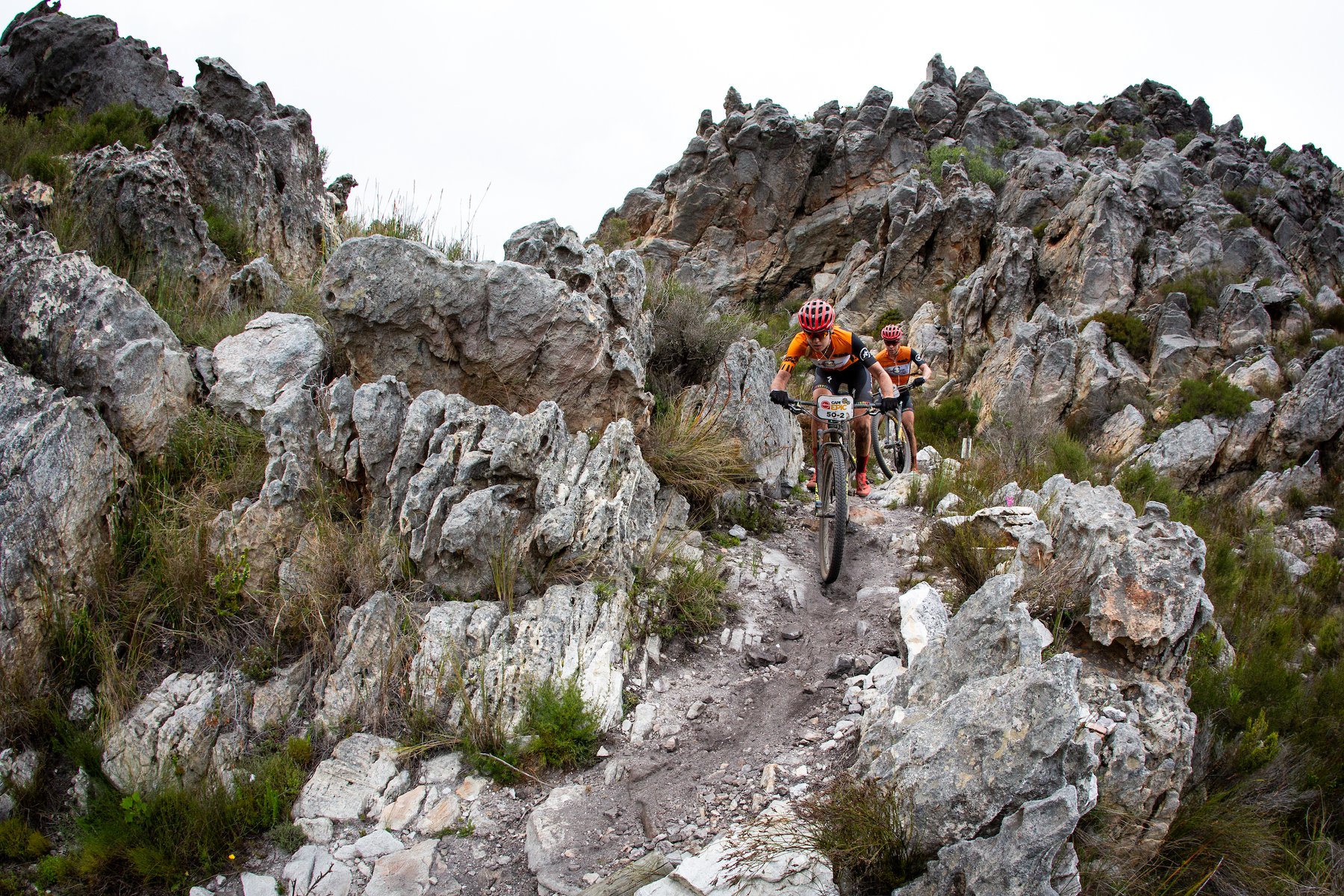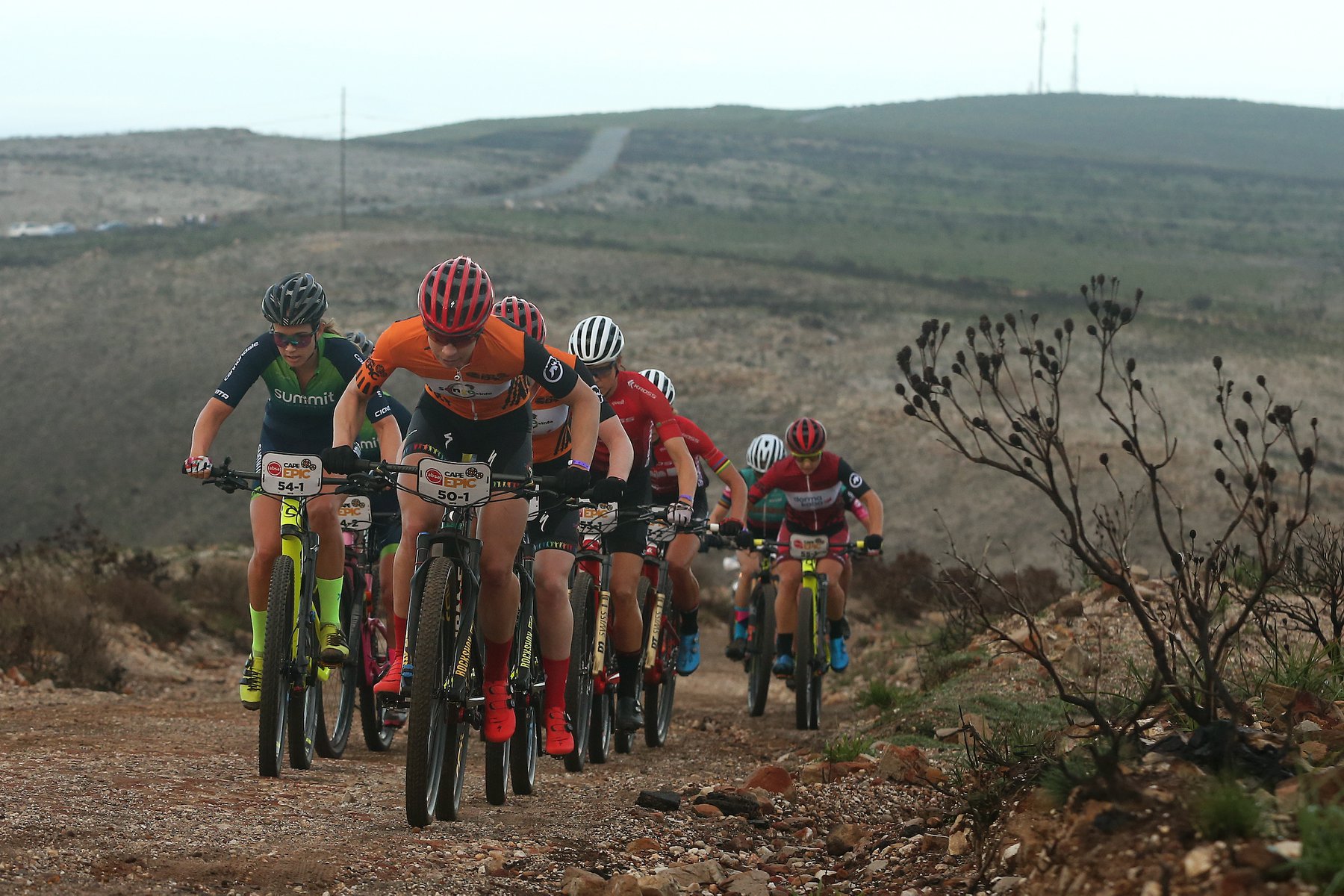Although the 2020 Absa Cape Epic was cancelled 36 hours before the start due to Covid-19, 1274 of the 1372 participants that entered the world’s most prestigious mountain bike stage race completed the annual rider survey, which reveals that the value of the average Absa Cape Epic participant’s bike is now R101 683. Find out which are the most popular bike brands for 2020 as well as other bike-related stats in this reveal.
By Sean Badenhorst

Photo: Sam Clark/Cape Epic
Sadly, the Absa Cape Epic didn’t take place in 2020, but over 1300 mountain bikers from around the world spent months preparing for it. The eight-day race is challenging to both riders and their equipment. Months of appropriate training is required just to finish the event within the daily cut-off times. The harsh, dry, rugged Western Cape conditions make bike and equipment choice just as important and many bicycle industry brands see the Cape Epic as the ultimate testing ground.
TREAD has been publishing the annual Absa Cape Epic rider survey stats for the past decade. We may not have had a race to reflect on this year, but we do have the rider survey data, which we will reveal in three parts. This is Part 1, which focusses on bicycles. Coming soon are Parts 2 (gear stats) and 3 (rider stats).
TABLES BEST VIEWED IN LANDSCAPE ON SMARTPHONES
Average bike value
| Year | Rand value | % increase over previous year | Cost of US $1 on 31 March that year |
| 2020 | R101 683 | 2.40% | R17.85 |
| 2019 | R99 296 | 2.21% | R14.30 |
| 2018 | R97 145 | 3.03% | R11.84 |
| 2017 | R94 286 | 23.97% | R13.29 |
| 2016 | R76 052 | 25.18% | R14.71 |
| 2015 | R60 752 | 35.19% | R12.12 |
| 2014 | R44 937 | 6.37% | R10.58 |
| 2013 | R42 244 | 4.69% | R9.24 |
| 2012 | R40 349 | 7.56% | R7.69 |
| 2011 | R37 510 | 4.49% | R6.84 |
| 2010 | R35 898 | 4.91% | R7.39 |
| 2009 | R34 215 | 11.59% | R9.72 |
| 2008 | R30 659 | R8.19 |
We include the Rand=US Dollar rate at 31 March for each year (the Cape Epic month) to add some perspective. It’s worth noting that R17.85 is close to the weakest the Rand has ever been against the Dollar (that was R17.95 on 30 March 2020).
The average price of a Cape Epic bicycle has finally gone into six figures (in South African Rand). After three huge increases (2014-2017), it’s been incremental since. By comparison, the average value of the bike of participants in our 2019 South African MTB Race Survey, presented by Garmin http://www.treadmtb.co.za/sa-mtb-race-survey-presented-by-garmin-bike-gear-preferences/ was R50 928-27, almost half. This confirms the importance placed on performance of bikes used by Absa Cape Epic participants as well as the significant investment they are prepared to make.
Breakdown of bike value (past 3 years)
| Price bracket | 2018 | 2019 | 2020 |
| Under R30 000 | 0% | 0% | 0% |
| R30 000-R40 000 | 3% | 3% | 2% |
| R40 000-R50 000 | 5% | 4% | 4% |
| R50 000-R60 000 | 7% | 6% | 5% |
| R60 000-R70 000 | 8% | 7% | 6% |
| R70 000-R80 000 | 11% | 10% | 8% |
| R80 000-R90 000 | 10% | 10% | 10% |
| R90 000-R100 000 | 10% | 11% | 10% |
| R100 000-R110 000 | 10% | 12% | 9% |
| R110 000-R120 000 | 7% | 7% | 8% |
| R120 000-R130 000 | 12% | 11% | 11% |
| Over R130 000 | 17% | 18% | 27% |
A total of 55% paid R100 000 or more for their bicycle. That’s up from 48% in 2019 and 46 % in 2018. Of the total 2020 entrants, 50% bought a new bike in the 12 months leading up to the Cape Epic – of these new-bike buyers, 34% were South African and 66% International. Note the big jump in bikes that cost over R130000? The most likely reason is SRAM XX1 AXS. The electronic shifting system increases the price of a bike by around R25-R30K over the mechanical SRAM XX1 set-up and is becoming increasingly popular for those with no budget restraints.

Photo: Sam Clark/Cape Epic
New bike purchase in previous 12 months
| 2016 | 2017 | 2018 | 2019 | 2020 |
| 59% | 52% | 54% | 57% | 50% |
Just on half of the 2020 Absa Cape Epic participants bought a new bike in the 12 months leading up to the event, the lowest in past five years. The Cape Epic has stopped asking the ‘hardtail vs dual-sus’ question because as of 2019, 96% of riders were on full-suspension bikes, unlikely to change much…
Most popular brands – last 8 years
| 2013 | 2014 | 2015 | 2016 | 2017 | 2018 | 2019 | 2020 | |
| Specialized | 23% | 29% | 36% | 36% | 32% | 33% | 30% | 31% |
| SCOTT | 11% | 15% | 14% | 12% | 14% | 15% | 15% | 14% |
| Cannondale | 7% | 10% | 9% | 10% | 12% | 12% | 13% | 11% |
| TREK | 7% | 5% | 4% | 4% | 6% | 6% | 6% | 8% |
| Orbea | — | — | — | — | — | 2% | 1% | 4% |
| Santa Cruz | 5% | 4% | 4% | 5% | 4% | 3% | 5% | 3% |
| Giant | 11% | 6% | 4% | 4% | 4% | 3% | 3% | 3% |
| Canyon | — | — | — | — | — | 2% | 2% | 3% |
| BMC | 3% | 3% | 3% | 3% | 3% | 2% | 2% | 2% |
| Merida | 5% | 4% | 3% | 1% | 2% | 2% | 2% | 2% |
| Pyga(RSA) | — | — | — | — | <1% | 2% | 1% | 2% |
| Momsen(RSA) | — | 3% | 2% | 3% | <1% | 2% | 1% | 1% |
| Silverback(RSA) | — | — | — | — | — | <1% | 1% | 1% |
Note: Other brands do feature in the survey results, but are all 1% or less, so haven’t been listed here. Combined, they make up 15% of ‘Other’.
Specialized held firm as the most popular bike brand – still by a large margin – with SCOTT and Cannondale both losing some ground but maintaining their positions from the past few years. TREK increased to 8%, the highest it’s ever been, while Spanish brand, Orbea moved up to 4% and fifth place. Santa Cruz dropped to 3%, while Canyon moved up to 3%. Of the three South African brands, Pyga saw the only increase, moving up to 2%.
Component split
| Shimano | SRAM | Other | |
| 2020 | 25% | 74% | 1% |
| 2019 | 24% | 76% | 0% |
| 2018 | 29% | 70% | 1% |
| 2017 | 44% | 56% | 0% |
| 2016 | 44% | 55% | 1% |
| 2015 | 44% | 55% | 1% |
| 2014 | 50% | 49% | 1% |
| 2013 | 51% | 49% | 0% |
| 2012 | 45% | 55% | 0% |
| 2011 | 46% | 53% | 1% |
| 2010 | 47% | 51% | 2% |
| 2009 | 57% | 41% | 2% |
| 2008 | 57% | 41% | 2% |
| 2007 | 61% | 36% | 3% |
Shimano managed to claw back a percentage to 25%, but SRAM continues to dominate the component category, largely because of its 1×12 Eagle drivetrains, which have become the standard on most mid-to-top-end bikes. Although Shimano launched its own 1×12 format in May 2018, it still has a lot of ground to make up on SRAM, which has since increased its 1×12 range even further.
Dropper seatpost
| 2017 | 2018 | 2019 | 2020 | |
| Yes | 17% | 21% | 31% | 42% |
| No | 83% | 79% | 69% | 58% |
Not really surprising to see an 11% increase from 2019 and a doubling from 2018. Dropper seatposts have been refined to be light and reliable and have become almost standard on top tiers of the XCO/XCM models for most brands. If used appropriately, they also improve your ability to control your bike on descents and through turns, which brings a performance benefit that requires no additional training or diet…

Photo: Sam Clark/Cape Epic
Drivetrain configuration
| 2016 | 2017 | 2018 | 2019 | 2020 | |
| Single chainring | 49% | 67% | 81% | 88% | No data |
| Double chainring | 48% | 30% | 17% | 11% | No data |
| Triple chainring | 3% | 3% | 2% | 1% | No data |
The Cape Epic has now stopped asking this question because of the obvious trend towards single chainring unlikely to change much. But looking back to 2016, it’s clear that the launch of SRAM’s 1×12 Eagle revolutionised drivetrain choice and it shows in all stage race survey stats over the past couple of years, with a significant jump from 49% two years ago to 88% at the Cape Epic in 2019 – and no doubt higher for 2020.
Will you replace your drivetrain before the race?
| Entirely | Cassette & chain only | Chain only | No | |
| 2020 | 32% | 24% | 22% | 19% |
| 2019 | 34% | 23% | 23% | 20% |
| 2018 | 33% | 24% | 22% | 21% |
| 2017 | 42% | 23% | 18% | 18% |
| 2016 | 57% | 18% | 15% | 10% |
| 2015 | 63% | 17% | 0% | 11% |
| 2014 | 57% | 19% | 12% | 12% |
| 2013 | 53% | 23% | 12% | 13% |
| 2012 | 53% | 23% | 10% | 14% |
| 2011 | 54% | 23% | 12% | 11% |
| 2010 | 50% | 24% | 14% | 12% |
| 2009 | 49% | 27% | 14% | 10% |
| 2008 | 56% | 22% | 10% | 12% |
Interesting to note the correlation in the percentage drop in ‘replacing the entire drivetrain’ (chain, cassette and chainring/s) and increase in ‘no, not replacing anything’, from 2018 to 2020. From 2018, single chainring drivetrains were on 81% of Cape Epic bikes, increasing in 2019 to 88%. We didn’t get a figure for 2020, but expect it would be over 90%. Single-chainring drivetrains have reduced drivetrain wear significantly and simplified drivetrain maintenance and management. If you’re a long-time mountain biker, you’ll share with us the huge relief this brings…



